How we get around
- Open data
- Sep 21
- 8 mins

Krushenka Bayas Design (Storydata)
Barcelona tops the list of European cities with the highest car density, 5,844 per km2. Although the traffic is twice that of Madrid and five times that of Berlin or Amsterdam, only one in three people get around with a private vehicle.
The Eixample is the nerve centre of motorised transport: approximately 350,000 vehicles pass through it every day. The concentration of air pollutants dropped to an all-time low as a result of the lockdown, and in 2021 it is still below the historical average. Electric scooters, whose use is on the rise, is a more eco-friendly transport alternative, but the number of scooter accidents is becoming increasingly significant.
The districts with the most motorised transport
With more than 1.5 million inhabitants and an area of 101.4 km2, Barcelona is the European city with the most cars per km2, as its surface area is smaller than other metropolises. Sarrià-Sant Gervasi is the Barcelona district with the highest density of cars per inhabitant: for every 1,000 people there are 393 cars and 244 motorcycles, according to the 2020 Vehicle Census. Pedralbes and Sant Gervasi-Galvany are the neighbourhoods with the highest vehicle density. The least motorised districts are Sants-Montjuïc, Nou Barris and Ciutat Vella.
The Eixample, an urban motorway
The busiest thoroughfare in the city is the Ronda de Dalt ring road, with approximately 157,000 vehicles passing through it every day. It is followed by another ring road, the Ronda del Litoral, with much lower numbers. Although the ring roads see most of the traffic, urban thoroughfares such as Avinguda Diagonal, Gran Via de les Corts Catalanes, Carrer d’Aragó, Carrer Balmes and Carrer Valencia are not far behind. The daily flow of vehicles passing through the Eixample can reach 350,000, a figure higher than the sum of vehicles travelling on the ring roads, according to figures from Barcelona City Council.
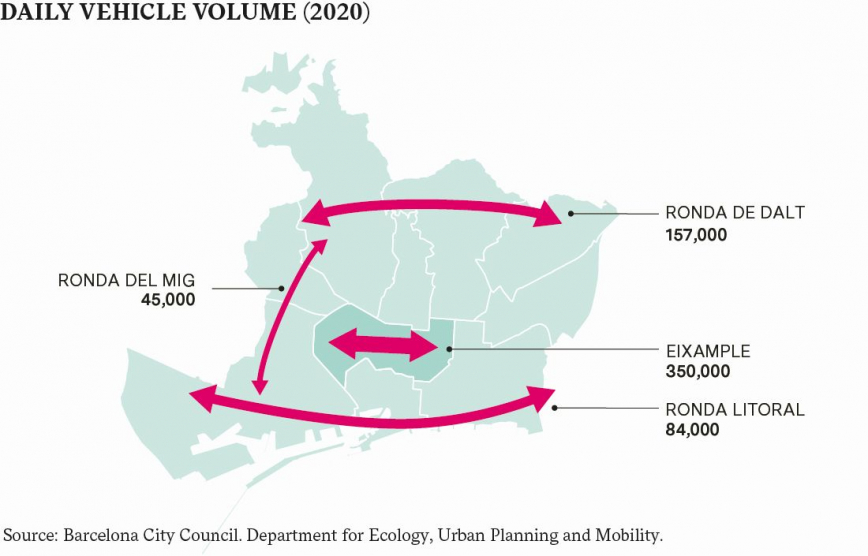
More cars than on the AP-7 motorway
There are four streets in the heart of the Eixample that see between 40,000 and 80,000 cars in one working day. In 2019, more than 84,000 cars a day passed through Carrer d’Aragó alone, much more than on the Ronda del Mig ring road (45,021) or Gran Via (55,321), according to the most recent figures available from Barcelona City Council. The other major urban thoroughfare is Avinguda Diagonal, which sees 62,000 vehicles daily. To get an idea of the magnitude, the AP-7 has an average of 80,000 vehicles a day on the Roca del Vallès stretch.
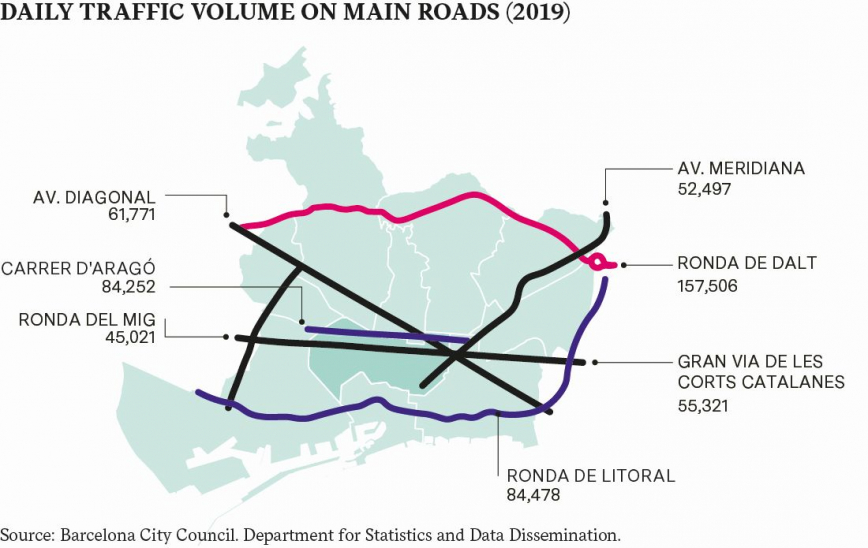
Walking, the leading option for getting around
Walking accounts for almost half of the day-to-day mobility of Barcelona’s residents (44.8%), according to the 2019 Working Day Mobility Survey, predominantly among women, accounting for 25% versus 19% for men. Cars constitute the second most common means of transport (31%), whose use is slightly higher among men. Only 17% of journeys are made on public transport, and women predominate among its users.
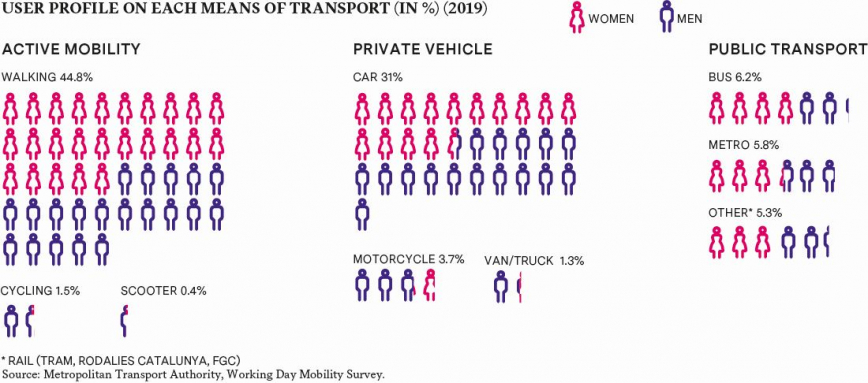
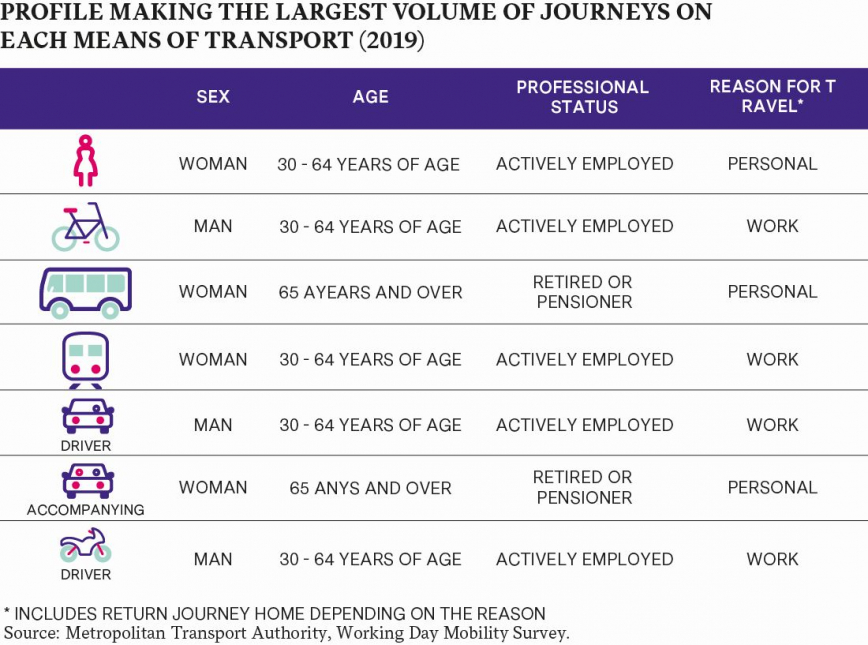
Travelling to and from home
The highest concentration of travel for work reasons occurs between 7 and 9 am, according to figures from the Barcelona Metropolitan Area (AMB). Conversely, travel for personal reasons, which is much more frequent, takes place between 8 and 11 am, and between 4 and 6 pm. Among the different forms of transport, active mobility (walking, cycling or scooter) predominates at almost all times of day.
Mobility flows
Every day, according to figures from the Barcelona metropolitan authority, there are more than 19 million journeys made throughout Catalonia. Out of these journeys, approximately 7 million enter or leave Barcelona. In addition, 5.2 million journeys are made within the city, either by private transport, public transport or active mobility.
Not including these internal journeys, the highest flow is between Barcelona and the first metropolitan area, with more than 1.1 million journeys.
Pollution exceeding the limits
Air pollution is one of the biggest public health problems in the European Union. If Barcelona and its metropolitan area managed to reduce it to the limits recommended by the World Health Organization (WHO), 1,000 natural deaths in the city would be avoided every year, according to the Barcelona Public Health Agency (ASPB). Nitrogen dioxide (NO2) and suspended particles are the main pollutants caused by traffic. The Eixample and the ring roads, the biggest traffic hubs, concentrate quantities of this element that exceed, and in some points are even double, the stipulated limits.
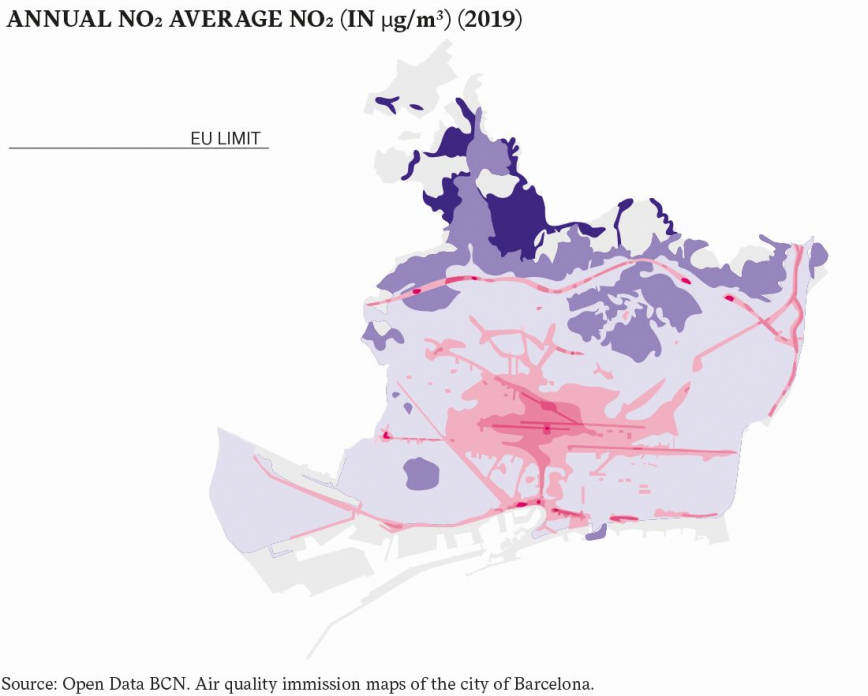
All-time lows as a result of COVID-19
Pollution figures during the lockdown confirm that restrictions on movement and economic activity to combat the pandemic made the city’s levels of pollution exceptionally low. For the first time in twenty years, no measuring station exceeded the nitrogen dioxide limits set by European regulations. According to the Barcelona 2020 Air Quality Report developed by the Barcelona Public Health Agency, the strictest lockdown phase saw a 43% fall in NO2 compared to the pre-COVID period. The population exposed to nitrogen dioxide above its legal limit fell by 91%.
The danger of suspended particles
Suspended particulate pollution also reached minimum levels during 2020, although the drop has been smaller than in the case of nitrogen dioxide. PM2.5 and PM10 particles are pollutants generated in the combustion of hydrocarbons and biomass. They are also produced by the dust of construction works and rubble, by tire and road wear, by vehicle brakes or by natural sources, such as Saharan dust. Lower levels of nickel (Ni), a pollutant emitted by factories, have also been detected. All measuring stations saw a decrease in suspended particles in 2020, although the levels continue to exceed those recommended by the WHO (20 μg/m2 in the case of PM10 and 10 μg/m2 in the case of PM2.5).
The slow transition to electric vehicles
In 2016, there were 1,773 “zero emission” or electric cars in Barcelona. By 2020, the number reached 12,235, accounting for 1.5% of the city’s total vehicle fleet. The neighbourhood that has seen the highest rise in electric vehicles in the last five years has been Sant Pere, Santa Caterina i la Ribera, with 3,899 more electric cars than in 2016. This neighbourhood is home to the headquarters of eCooltra, which rents out electric mopeds. It is followed by the neighbourhoods of El Parc i la Llacuna del Poblenou (1,560) and La Marina del Prat Vermell (899). Also noteworthy are the neighbourhoods of Les Corts, L’Antiga Esquerra de l’Eixample and El Bon Pastor. In the latter neighbourhood, most vehicles are electric vans and trucks. The city has 123 electric vehicle recharging points, with a total of 582 connectors. In January 2021, this became a paying service.
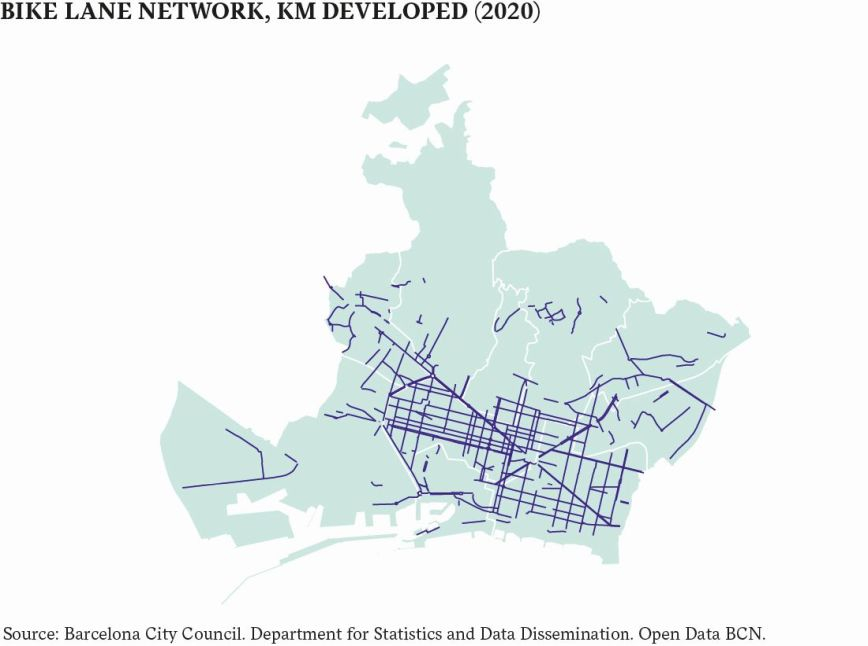
Expansion of the bicycle lane network
Cycling is synonymous with zero emissions. Barcelona has 231 km of cycle lanes, which are concentrated in the Eixample and Sant Martí districts, although the network’s expansion is underway across all districts. The goal is to reach 308 km by 2024. In addition to extending the bicycle lane network, the city’s 2024 Mobility Plan aims to have more 30 km/h lanes to promote the compatibility between motor vehicles and bicycles, to increase the number of electric Bicing bikes and to create safe parking facilities for these vehicles.
Year with fewer accidents
The year of the pandemic saw the lowest number of accidents, injuries and fatalities since the figures became available. In 2020, the number of traffic accidents in the city of Barcelona fell to 7,212, and the number of people injured in accidents to 7,198. One year earlier, these numbers exceeded 10,000 accidents and 11,000 injuries.
Fourteen in 2020
We are very far from the figures of the eighties and early nineties, when Barcelona recorded an average of between 70 and 80 accident fatalities per year. With the lockdown, there was a fall in the number of accidents in 2020, which had 14 fatalities.
Scooters disrupt the city
Scooters, as well as other motorised and non-motorised personal mobility vehicles (PMV), have witnessed a boom thanks to the reengineering of these vehicles, which has equipped them with great features. That said, their rise has also turned the urban ecosystem upside down. Some of these vehicles reach speeds of up to 50 km/h, and there are still doubts about how and which roads can be taken with a PMV. In 2020, up to 505 scooters were involved in traffic accidents, according to figures from the Guàrdia Urbana city police. The vast majority occurred in the Eixample district, the city area with the most traffic and the highest concentration of kilometres of cycle lanes.
The Eixample and Sarrià-Sant Gervasi, in the spotlight
According to the list of vehicles involved in accidents handled by the Guàrdia Urbana city police in Barcelona in 2020, the Eixample is the district with the most motorised and non-motorised scooters involved in traffic accidents, followed by Sarrià-Sant Gervasi and Sant Andreu. The year 2020 saw a decline in the number of accidents in most districts, linked to the lockdown’s movement restrictions. However, the districts of Sants-Montjuïc, Sant Martí and Nou Barris registered more scooter accidents than in 2019.
Electric scooter flows
The district that generates and attracts the most electric scooter users is the Eixample, according to the report “Assessment of the Impact of Electric Scooters on Mobility in the Barcelona Metropolitan Area”, a survey that includes the data of 200 electric scooter users. The other areas with the highest use of this type of vehicle are Sants-Montjuïc and Ciutat Vella, and those registering the lowest use are Nou Barris and Sant Andreu.
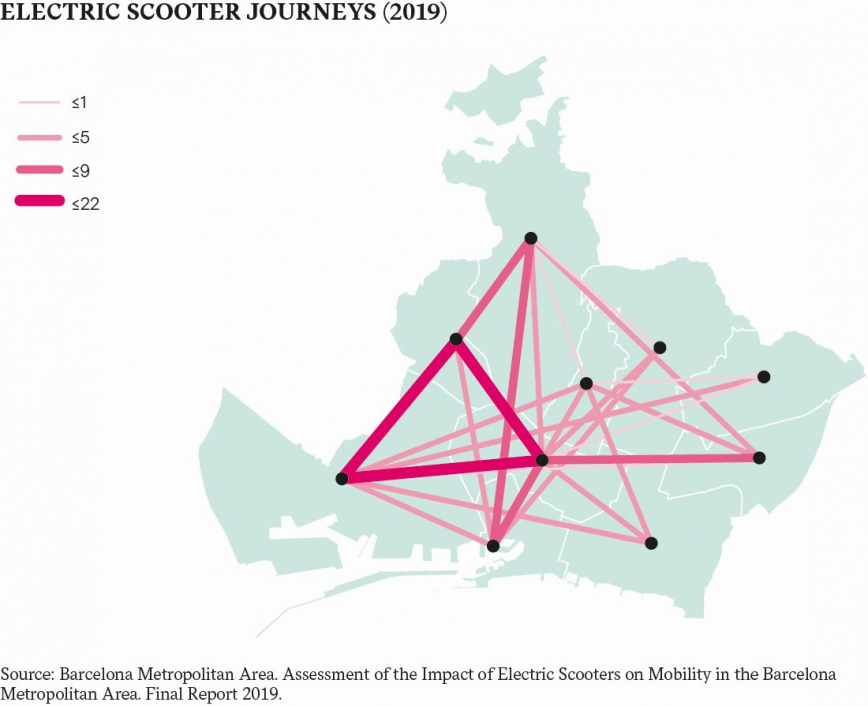
The newsletter
Subscribe to our newsletter to keep up to date with Barcelona Metròpolis' new developments





